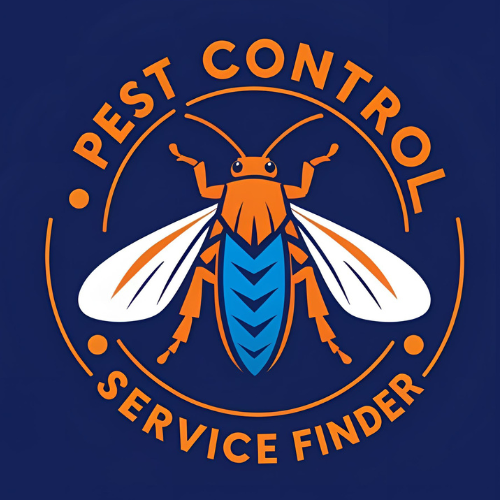Natural Home Remedy Roach Killer Guide
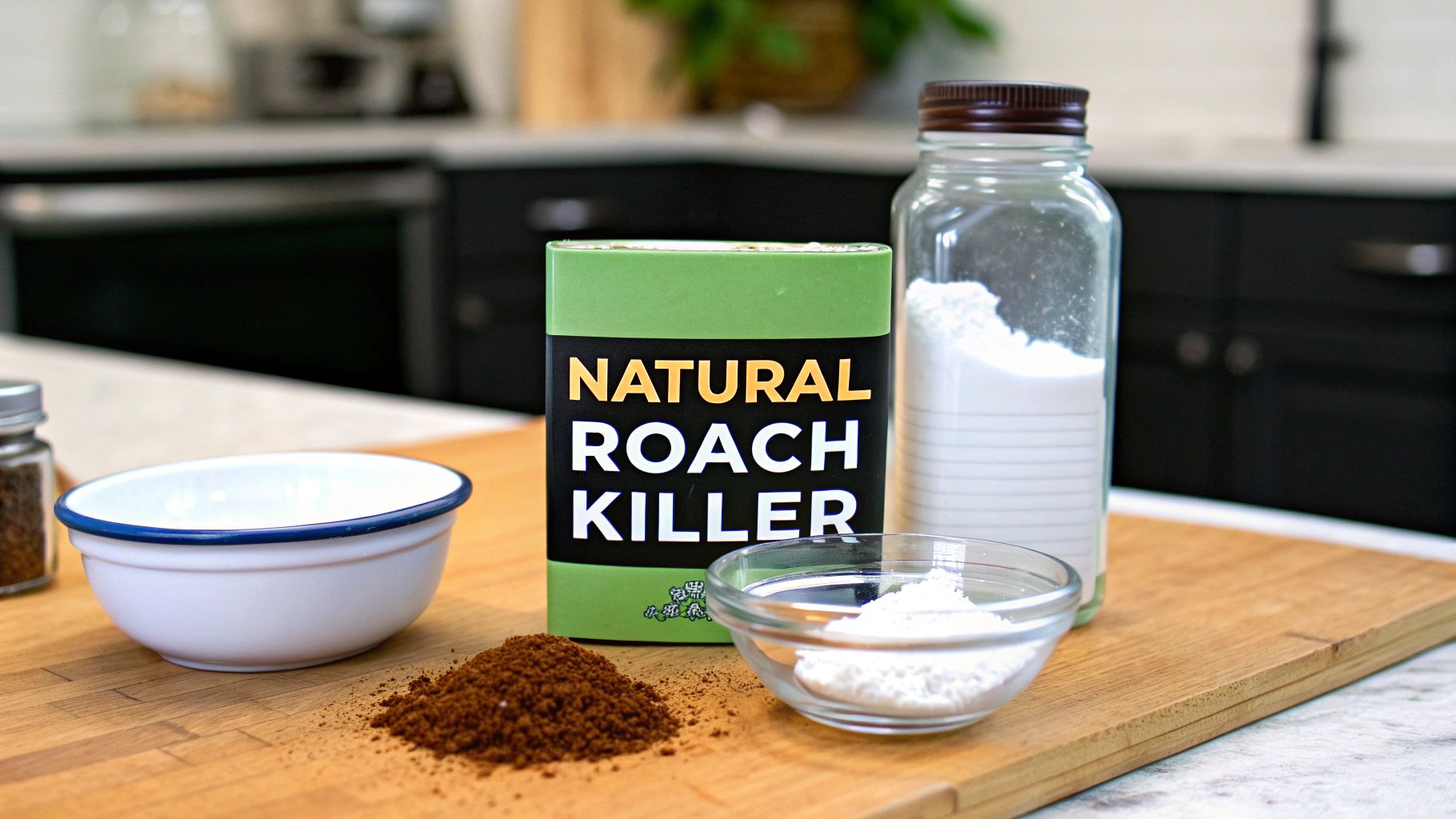
Dealing with a roach infestation and need immediate professional help? Call +1 855 224 3071 now. For everyone else looking to tackle the issue themselves, one of the oldest tricks in the book is a simple home remedy roach killer: mixing equal parts baking soda and powdered sugar. This combo works as a deadly bait for any roach that eats it.
Your Guide to Natural Roach Control at Home
There’s nothing worse than that sinking feeling you get when you see a roach scurry across your floor. For a lot of us, reaching for a can of harsh chemical spray just isn't an option, especially with kids or pets running around. If you’re feeling overwhelmed, remember that professional help is always just a phone call away at +1 855 224 3071.
But if you're ready to try a few things first, this guide will walk you through reclaiming your space with ingredients you probably already have. We'll get into the DIY roach killers that actually work, why they work, and what you can realistically expect.
The idea of using a home remedy for roaches isn't anything new. Many people would much rather try a DIY approach before bringing commercial pesticides into their homes. It’s a growing trend driven by concerns over chemical exposure. In fact, surveys show that around 30% of U.S. households have tried a home remedy before buying a commercial product. This shows a real preference for natural solutions, which you can read more about in roach control market reports.
What to Expect from DIY Roach Killers
It's important to be realistic. While home remedies are fantastic for knocking down a smaller roach population, they have their limits. They take time, require consistent effort, and might not be enough to wipe out a deeply entrenched infestation on their own. For severe issues, don't hesitate to Call +1 855 224 3071.
- Affordability: You're using common household stuff. It’s a very inexpensive way to start fighting back.
- Safety: When you do it right, these natural solutions are much safer for your family and pets than traditional insecticides.
- Effectiveness: They work best when you combine them with other smart moves, like a deep clean and sealing up cracks where roaches get in.
My best advice? Don't rely on just one method. The most successful approach is hitting the problem from multiple angles at once. Set out some baits while also creating barriers. This multi-front attack dramatically increases your chances of winning.
Below is a quick overview of some of the most effective DIY roach killers.
Top Home Remedy Roach Killers at a Glance
This table breaks down the go-to remedies many people have found success with. It covers what you need, how it works, and why it's a good option to try.
| Remedy | Key Ingredient(s) | Mechanism | Primary Benefit |
|---|---|---|---|
| Baking Soda & Sugar | Sodium bicarbonate, Sugar | Ingestion causes a chemical reaction, producing gas that ruptures the roach's digestive system. | Non-toxic to pets and humans; highly effective when consumed. |
| Boric Acid | Boric acid | Acts as a stomach poison upon ingestion and damages the exoskeleton on contact. | Long-lasting residual effect; remains potent as long as it stays dry. |
| Diatomaceous Earth (DE) | Fossilized diatoms | Abrasive particles physically cut through the roach's waxy exoskeleton, causing dehydration. | A mechanical killer, meaning roaches cannot build an immunity to it. |
| Soap & Water Spray | Liquid soap, Water | The soap clogs the roach's respiratory pores (spiracles), causing it to suffocate. | Instant, non-toxic contact killer for roaches you see out in the open. |
Each of these has its place in a solid DIY pest control strategy. Now, let’s get into the practical steps for using them effectively in your home.
If you're spotting roaches but the DIY approach isn't working, it's time to call in the pros. Get immediate help by calling +1 855 224 3071.
For smaller problems, one of the oldest and most effective home remedies is a simple mix of baking soda and sugar. It's a classic for a reason. This trick turns a roach's sweet tooth against it—the sugar acts as the irresistible bait, while the baking soda is the poison they never see coming.
When a roach eats the mix, the baking soda reacts with its stomach acid, creating carbon dioxide gas. Roaches can't pass gas, so the pressure just builds and builds internally until it becomes lethal. It's a surprisingly effective, non-toxic method for household use.
Creating and Placing Your Bait
Whipping up this potent roach killer is incredibly simple. All you need to do is mix equal parts of baking soda and powdered sugar. A 1-to-1 ratio is perfect. For example, mix a quarter cup of baking soda with a quarter cup of powdered sugar and give it a good stir.
Now, where you place the bait is just as important as how you make it. You have to think like a roach. Where are they hiding? Where do they travel? Your goal is to sprinkle small amounts of this mixture in their favorite hangout spots.
- Under Sinks: Kitchen and bathroom sinks are prime real estate for roaches because of the constant moisture.
- Behind Appliances: The dark, warm spaces behind your fridge, microwave, and oven are perfect roach hideouts.
- Inside Cabinets and Drawers: A light dusting in the back corners of your cabinets—especially where you store food—can catch them where they forage.
The key is to use this baiting technique as part of a bigger strategy. You have to remove what attracts them in the first place.
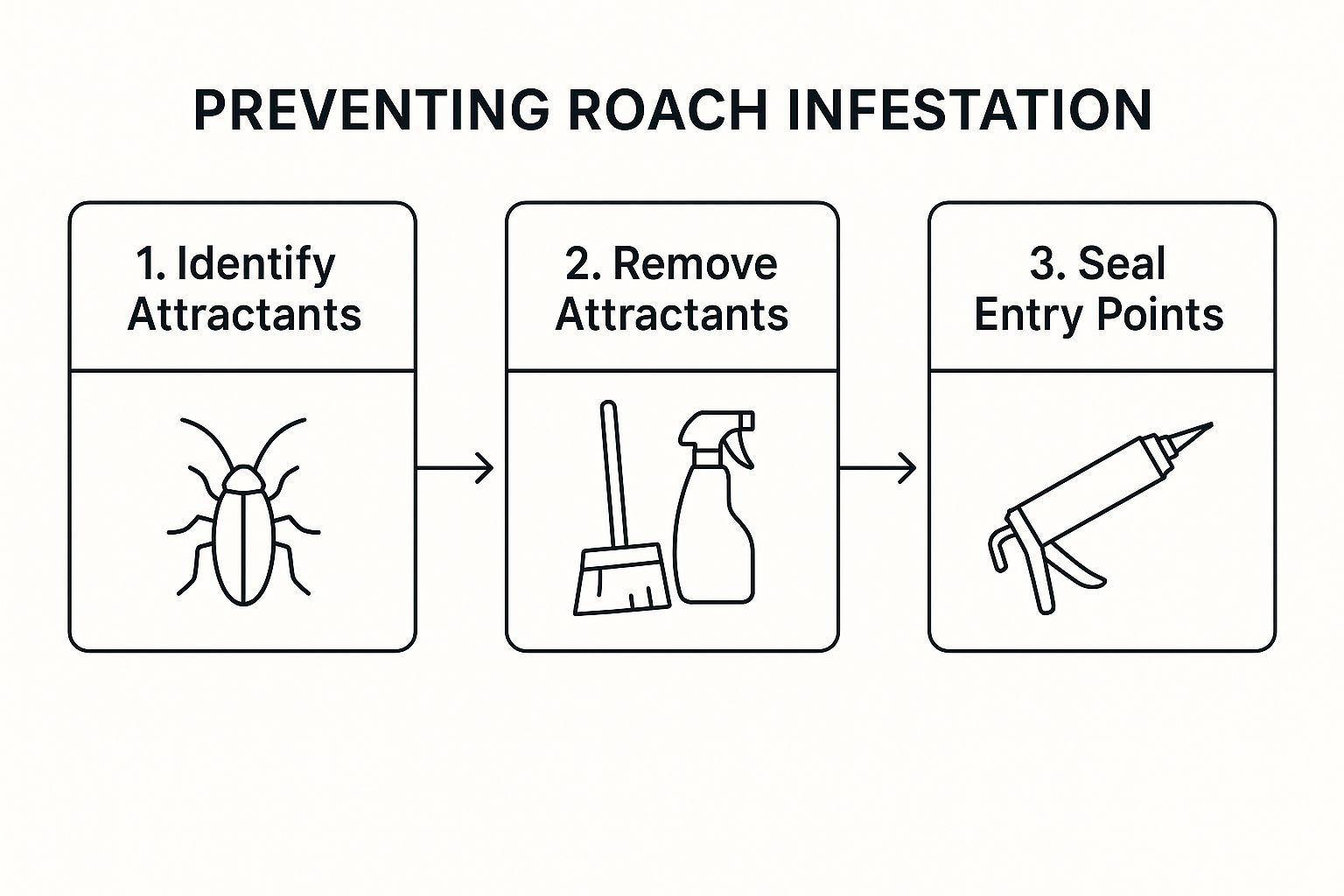
As you can see, killing the roaches you have is just step one. Making your home a less inviting place for the next wave is the real long-term solution.
Pro Tip: Roaches can be wary. Don't just leave piles of powder out. Place your bait in shallow containers they can easily get into, like bottle caps or small squares of cardboard.
To keep this remedy effective, you'll need to replace the bait every couple of days to keep it fresh and appealing. If you've done this consistently and you're still seeing a lot of activity, that's a sign you need professional backup. Don't wait—call +1 855 224 3071 for a full assessment and treatment.
When a roach problem feels like it's spiraling out of control, you need a fast solution. For immediate professional help, Call +1 855 224 3071. But if you're looking for a powerful, long-lasting DIY approach, boric acid is one of the most effective weapons in your arsenal.
Using Boric Acid for Lasting Roach Elimination

Boric acid isn't a bait that roaches need to eat. It's a fine powder that works in a much stealthier way. When a roach scurries through the powder, it sticks to their legs and antennae. Later, when the roach grooms itself, it ingests the poison.
Even better, it carries that deadly dust back to the nest, spreading it to others who never even came close to your application spot.
The trick to making this work is all in the application. You can't just dump piles of it around. Roaches aren't stupid; they'll walk right around a big clump of white powder. You need to apply a very fine, almost invisible dusting. A thin, undetectable layer is what makes it so lethal.
Strategic and Safe Application
Let's be clear: safety is non-negotiable here. Boric acid is a naturally occurring compound, but it is toxic if ingested by people or pets. You absolutely must keep it away from kids and animals.
That means never using it on countertops, inside food pantries, or any open area where a curious pet or child could get to it. If that feels too risky for your home, sticking with the pros is the smartest move. Call +1 855 224 3071 for pet-safe and family-safe solutions.
To apply it correctly, focus on the hidden highways roaches use to travel through your home.
- Behind and Under Appliances: Carefully pull out the refrigerator, stove, and dishwasher. Apply a light dusting along the wall behind them where they'll walk undisturbed.
- Inside Wall Voids: Use a puffer or bottle to puff a small amount into the gaps around pipes under sinks and behind electrical outlet covers.
- Along Cabinet Edges: Target the very back corners of your cabinets (where the walls meet the floor) and under the toe kicks.
One of the biggest advantages of boric acid is how long it lasts. As long as the powder stays dry and undisturbed, it remains effective for months. It creates a deadly defensive barrier that keeps working long after you've put it down.
This long-term effect makes boric acid a fantastic part of a larger pest control strategy. It’s a slow, steady, and silent killer working in the background to provide continuous protection.
If you're dealing with a serious roach infestation and need help now, Call +1 855 224 3071. For those of you tackling smaller issues with non-toxic solutions, food-grade diatomaceous earth (DE) is a fantastic tool that kills roaches through simple physical contact.
Using Diatomaceous Earth for a Physical Takedown
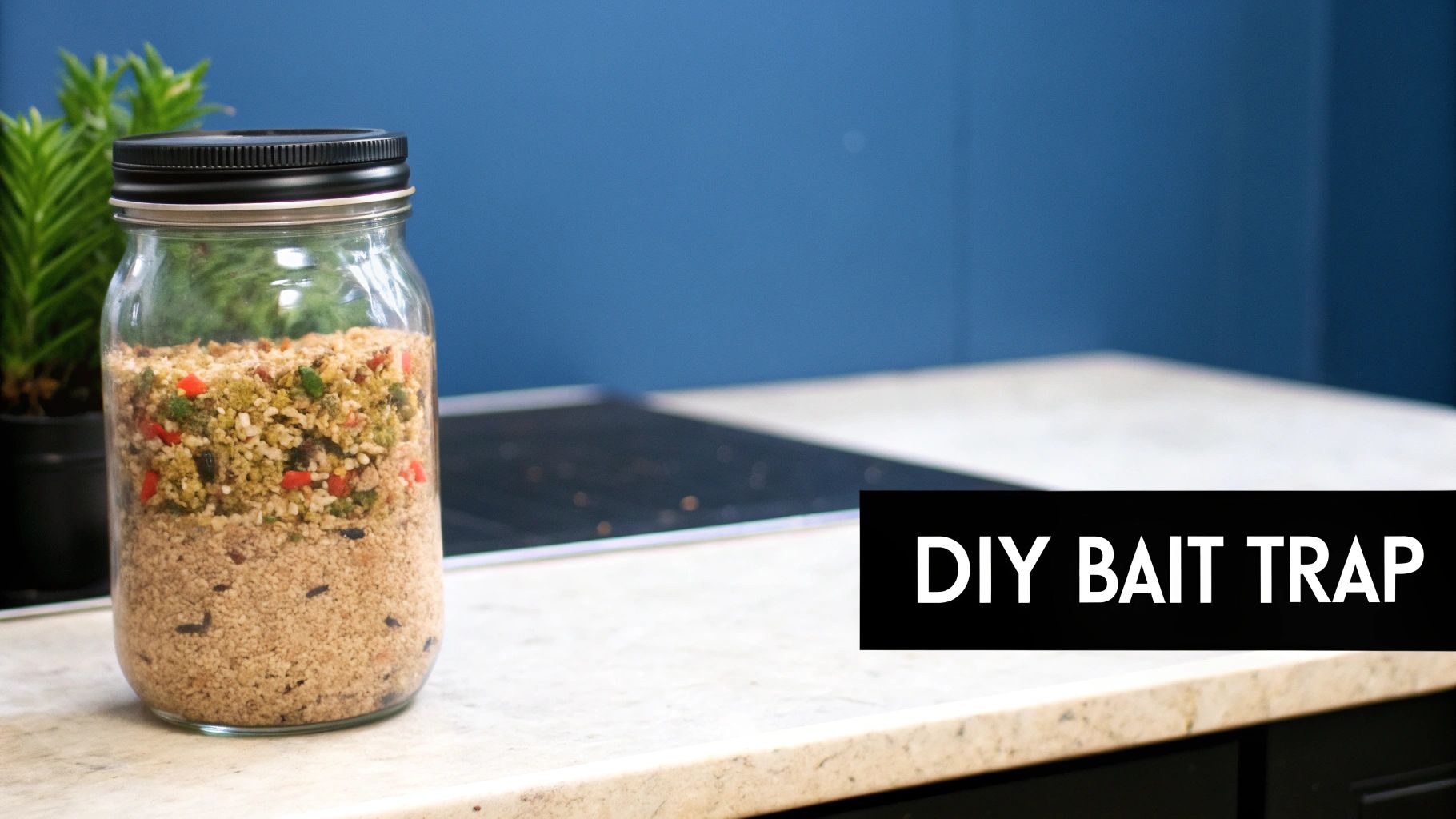
When you want a completely non-chemical approach, diatomaceous earth is one of the best things you can have in your arsenal. It’s a fine powder made from the fossilized remains of tiny aquatic organisms called diatoms. To us, it feels soft like flour, but on a microscopic level, it's covered in razor-sharp edges.
Here’s how it works: a roach crawls through the DE, and those tiny sharp particles scratch and cut away the waxy outer layer of its exoskeleton. This protective coating is what holds moisture in. Once it's damaged, the roach can't stop itself from dehydrating, and it eventually dies. Because this is a mechanical kill, not a chemical one, there’s no way for roaches to build immunity to it.
Long before we had modern commercial pesticides, people relied on natural substances just like DE to control pests. While many home remedies are cheap, they often struggle against severe infestations without constant reapplication. You can learn more about the history of home insecticides and their market to see how things have evolved.
How to Use Diatomaceous Earth the Right Way
The biggest mistake people make with DE is using way too much. Roaches are smart enough to just walk around big piles of white powder. The real trick is to apply a very fine, almost invisible dusting in the dry, out-of-the-way spots they love to travel. A small powder duster or an empty squeeze bottle can help you get that light coating.
Focus on these key hiding spots:
- In the cracks where baseboards meet the floor.
- Underneath heavy appliances like your fridge, stove, and dishwasher.
- Inside wall voids where pipes or electrical lines come through.
The most important thing to remember about diatomaceous earth is that it only works when it's bone dry. If it gets wet, those sharp edges become useless. This makes it a perfect barrier for dry areas where you wouldn't want to use a liquid spray anyway.
If you’ve tried DE and other methods but you’re still seeing roaches, that’s a sure sign the infestation is too big to handle on your own. Don't wait for it to get worse. Call +1 855 224 3071 to get immediate help from a professional.
If you've got a stubborn roach problem that simple prevention won't solve, you need to bring in the pros. Call +1 855 224 3071 for immediate help.
Once the current infestation is handled, the real work begins: making sure they never feel welcome again. Getting rid of the roaches you see is only half the job. The long-term win is making your home a place they'll actively avoid.
Preventing Future Roach Infestations Naturally
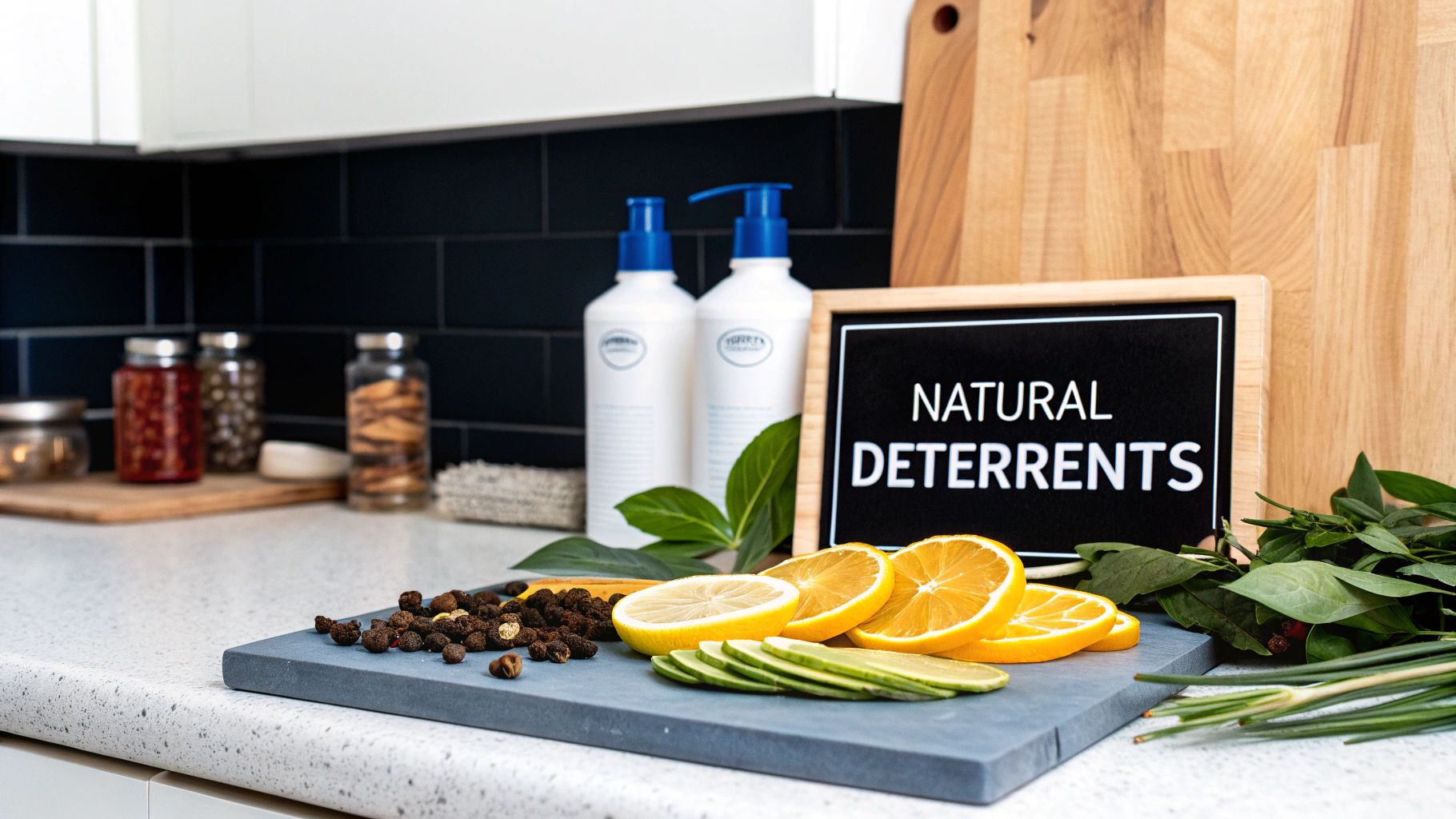
A proactive strategy is all about denying them the three things they need to survive: food, water, and shelter. Roaches are tough, but they can't set up shop without these basics. If you do your best and they still come back, it's a huge red flag that there's a bigger issue at play. Don't wait—Call +1 855 224 3071 and let an expert figure it out.
Create a Roach-Proof Environment
Your first move should be a deep clean and a thorough inspection of your home. You're on a mission to cut off every possible food and water source that could invite new roaches in.
- Lock Down Your Food: Get everything out of cardboard boxes and flimsy bags. Store pantry staples like flour, cereal, and sugar in airtight containers.
- Cut Off Their Water Supply: Fix that leaky sink or dripping pipe right away. Roaches can live off just a few drops of water a day.
- Stay Spotless: Make a habit of wiping down counters every night, sweeping up crumbs, and never, ever leaving dirty dishes out. Make sure your trash cans have lids that seal tightly.
Once you’ve cleaned up, it’s time to physically bar the door. Grab some caulk and seal up every crack and gap you can find—along baseboards, around pipes, and inside cabinets.
Think of prevention as creating an invisible fortress around your home. Every crumb you clean and every crack you seal is another brick in that wall, making it harder for pests to breach your defenses.
You can also use scents they hate to make your space less appealing. Tossing a few bay leaves in the pantry or leaving cotton balls soaked in peppermint oil in your cabinets can act as a natural deterrent. While these home remedies won't wipe out an existing infestation, they do a decent job of telling new roaches to keep moving.
For more expert advice on keeping pests out, check out our pest control blog.
Is your roach problem not getting any better? For an immediate consultation with a professional, Call +1 855 224 3071 right now.
While a homemade roach killer can sometimes knock down a few scouts, you have to know when you're outgunned. Recognizing the signs of a serious infestation that DIY methods just can't touch is the most important step.
Knowing when to switch from home remedies to calling in the pros is critical. If you feel like you've tried everything and the roaches are still marching on—or worse, multiplying—that’s a huge red flag. It means the real source of the problem is hidden deep within your walls, and you simply can't reach it. For fast help, Call +1 855 224 3071.
Telltale Signs of a Major Infestation
A few unmistakable signs tell you the roach population has exploded beyond your control. If you spot even one of these, it's time to get an expert on the phone.
- Daytime Sightings: Roaches are nocturnal creatures. Seeing them out and about during the day is a bad sign. It usually means their hiding spots are so overcrowded that they’re being forced out into the open to find food.
- Widespread Droppings: Finding little specks that look like black pepper or coffee grounds in multiple places—kitchen cabinets, silverware drawers, behind the fridge—points to a large and very active population.
- A Distinctive Smell: A large-scale infestation produces a smell you won't forget. It's a persistent, oily, and musty odor that cleaning just can't get rid of.
These signs are more than just creepy; they signal a real health hazard. Roaches are known to spread bacteria, trigger nasty allergies, and make asthma worse, especially for kids. Once an infestation gets to this level, only professional-grade treatments will wipe it out completely.
The demand for effective roach control is huge, with the global market projected to hit over $2.3 billion by 2032, largely because of health concerns in cities. You can dig into more stats on this growing problem over at dataintelo.com.
A professional exterminator has the experience to identify the exact roach species, find their main nesting areas, and create a targeted plan to eliminate them. When the situation feels hopeless, getting a professional assessment is the smartest move you can make.
If you're ready to find a vetted local expert, you can quickly connect with a Pest Control Service Finder in your area. Don’t let a severe infestation put your home and health at risk—Call +1 855 224 3071 for fast, effective relief.
Common Questions About Homemade Roach Killers
Feeling overwhelmed by your roach problem and just need a quick, straight answer? Call +1 855 224 3071 for an immediate consultation. When you start using DIY roach killers, a lot of questions pop up. I’ve heard them all, so here are the answers to the most common ones.
How Long Until I See Results?
The honest answer? It depends on what you're using.
A baking soda bait can take out a roach within 24 hours of it being eaten, which is pretty fast. Diatomaceous earth, on the other hand, isn't instant. It works by dehydrating them, so you might not see a dead roach for a couple of days.
Boric acid is the slow-burn of the group. It can take up to a week for a single roach to die, but the real power is how it spreads through the nest like a virus. No matter which method you choose, you have to be consistent. One-time application just won't cut it.
Are These Remedies Safe for Pets and Kids?
Safer than chemical sprays? Generally, yes. Completely foolproof? No. You absolutely have to use them with care.
Food-grade diatomaceous earth is pretty benign, but boric acid is a different story—it's toxic if ingested.
You must place boric acid where there is zero chance of a child or pet getting to it. Think deep inside wall voids, way under the fridge, or behind heavy appliances that never move. If you're not 100% confident, Call +1 855 224 3071 for professionally applied, family-safe treatments.
Can I Combine Different Home Remedies?
Not only can you, but you should. Using a multi-pronged attack is almost always more effective than relying on a single tactic.
Think of it like offense and defense. You can set out baking soda baits to actively lure in and kill foraging roaches (your offense) while laying down a barrier of diatomaceous earth in cracks and along baseboards to kill any that try to cross (your defense). This combination hits them from multiple angles and can seriously disrupt their population.
If you've given it your all and the roaches are still winning, it’s probably time to call in the professionals. Pest Control Service Finder is a great resource that connects you with vetted, local exterminators who can get the job done right. For immediate assistance, Call +1 855 224 3071.
You can get a no-obligation quote by visiting https://pestcontrol-service-finder.com.
